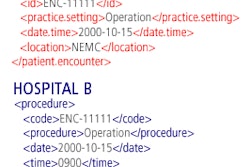"What's in it for me?" As the leader of the team tasked with implementing voice recognition (VR), answering this question from various perspectives is the key to your project's success. Radiologists have heard the horror stories about voice recognition systems -- involving longer days, more frustration, taking on a second job as a transcriptionist, and the list goes on. It's your responsibility to put the radiologists at ease and gain their acceptance prior to beginning the implementation.
The strategies we have developed for implementation of voice recognition technology come primarily from our experiences at Inland Imaging, a 60-member private radiology practice based in Spokane, WA.
Strong support and leadership
Leadership for voice recognition typically emerges early in the process. The radiologists who are asking to purchase voice recognition become the advocates during the implementation. What's important in developing a leadership strategy is that the radiologist leadership, executive leadership, operational leadership, and information technology leadership all begin to sing the same tune. This group needs to define a clear and concise project summary statement that outlines -- in terms that everybody can understand -- exactly what your organization needs to achieve.
For Inland Imaging, whose dictations were typed into multiple RIS and HIS databases each requiring an e-signature, the summary statement was: "A single worklist, single dictation system, and a single signature queue, regardless of the origin of the study." This one sentence captured the essence of what was needed to make this project a success, and allowed everybody involved to relate to the goal.
When beginning to build support, consider your organization's culture. Who in the company has the respect of his or her colleagues? Who is known for being more resistant to change? Who is less tech-savvy?
Consider pulling in this diverse group of representatives into a VR task force that can meet at defined intervals to address issues and help break down barriers to success. Then use this task force to educate its members on voice recognition -- keeping in mind that this is usually new technology for 90% of those involved. This task force can also function as the decision-making body behind the implementation.
In this phase, be sure to clearly identify the project roles and responsibilities. Who will function as the executive sponsor, working to overcome barriers or sometimes make a difficult decision? Who will be the project management lead? Who on the project team will manage specific areas such as server administration, communication, end-user training, and application expertise?
If you're struggling to gain support for the implementation, consider visiting other successful reference sites. Seeing voice recognition working in a similar environment can provide an excellent opportunity to gain the support of key radiologists or administrators. If a site visit isn't possible, a conference call with a reference site may suffice.
Define the success measures
This is where you can answer the question, "What's in it for me?" For some organizations, the decision to implement VR is financially motivated. For others, it's based on improved patient care through significantly faster report turnaround time. Perhaps it's improved radiologist satisfaction through better workflow. Most likely, the answer is a combination of these factors.
Try using a "Gallery Walk" brainstorming technique to generate what's important to your task force. If you're not familiar with this process, a "Gallery Walk" is where each participant places the success measures important to them on flip charts around the room. Each flip chart may be labeled with a topic, such as financial, patient care, workflow, etc., to help organize the comments.
Once all suggestions are placed on the flip charts, a second pass can be made by the participants to place dots on the measures that they now find most important. Using this process can allow your team to reach quick consensus on key issues for your organization.
Be sure to consider the audience when communicating your success factors. For example, a financial benefit of VR is usually a reduced number of transcriptionists currently in your organization. Communicating this to your transcription department is a very difficult task. Put them at ease by clearly explaining your objectives and the multiple options available to them.
Perhaps your current group is supplemented by a third-party transcription company; this area can be cut first. Or share your company's vision for growth, in which there may be an opportunity to create more reports with the same number of transcriptionists.
Once these success measures have been defined, it's time to submit a definitive plan to measure and report on the progress of meeting these goals. It's important to agree how these measures will be calculated prior to the implementation; this will ensure a nonbiased reporting approach once the results begin to materialize.
Maximize benefit, minimize effort
First, let's address minimizing the effort of the radiologist to adopt voice recognition. Be prepared for the change to speech recognition to be significantly more difficult than implementing PACS. The method in which radiologists dictate is as ingrained into their memory as riding a bike, and the transition to voice recognition is like beginning to ride a two-seater with a partner. A typical working day in the life of a radiologist leaves little time for distractions, so the VR implementation plan will need to be carefully crafted to fit in with your organization's environment.
Most organizations prefer to do the initial training of the radiologists during a normal working day, as this approach makes the most short-term economic sense. If possible, avoid this practice. Dedicated training time for each radiologist is the best method for initial training, away from the pressure of production and disruptions. Consider doing whatever it takes to get the radiologist's dedicated attention to learn the system -- up to four to six hours, if possible.
Then, take this opportunity to introduce the application, enroll the radiologists (creating their voice profiles), and begin to build up good recognition rates. Ideally, you can craft a solution that allows for the radiologists to begin interpreting live cases during the second half of this training session. This allows them to put the new technology to use against real work; however, at a very controlled pace.
Secondly, you need to make every effort to maximize the benefit they will receive. Inherent in voice recognition is the use of templates and autotexts. During the implementation process, analyze the current normal reports that are likely in place, and see if these can be created in the new system to be available from the first interaction. If even 10% of reports can be created with a single command, the instant benefit to the radiologist can be significant.
A typical radiologist statement that must be addressed is, "I am not a transcriptionist." You can respond to this statement on three levels. First, stress the improvement in patient care when the radiologists are able to review and edit the report at the same time as reviewing the films. No longer do they need to recall whether it was a left or a right shoulder MRI. The accuracy of the report immediately increases.
Second, by editing at the time of the report, they eliminate the time-consuming process of logging into the RIS/HIS at a later time and reviewing the report. Third, the ability to send to transcription still exists if they so desire.
To truly realize the full benefits of voice recognition for the radiologists, Inland Imaging is in the process of deploying advanced integration, the goal of which is to eliminate the need for radiologists to repeat factual information that is already captured elsewhere downstream. Termed "parroting," this is estimated to comprise 10% to 30% of the report content. By automatically inserting data such as technique, contrast amount, exam description, and clinical history into the report via HL7 integrations to multiple RIS, HIS, and a custom-built online forms tool, Inland expects to further increase the radiologists' efficiency.
Provide sufficient internal support
The analysis of your administrative support needs should also reflect your organization's culture. Who needs to be involved to facilitate the removal of any barriers? Who is respected and/or possesses clear authority to help sell the change to the rest of the organization? Who has time to dedicate to the project? Once these questions are answered, the administrator(s) chosen should be involved throughout the entire course of the project. This person plays a key role in effective and accurate communication to the rest of the executive team.
On the operational side, voice recognition will touch all areas of your organization -- from medical records to billing, from the floors to the ER, from the transcription department to the IT department. It will involve many of your clinical systems, including your RIS, HIS, PACS, billing system, and departmental-level reporting systems such as the obstetrics ultrasound reporting system or a vascular reporting system.
Including leaders in each of these areas during the discovery and planning stages is critical in gaining hospital-wide support. Designate your in-house trainers from this group of employees, and invest heavily in their understanding of the integration, workflow, and functionality of the voice recognition system.
At Inland Imaging, an in-house trainer was designated to be with each radiologist for the first three days when they began using the technology. This level of support tapered to half of every day for the next three days, then reached a point in which only a phone call was necessary to check in on each radiologist. Keep in mind that each radiologist will be unique -- some needing more support and some needing less.
Once the radiologists have reached an acceptable performance level, the training job is only half complete. It's important to schedule follow-up visits to continue to give tips and pointers to the radiologists to increase their familiarity with the application. Consider peer-to-peer interactions between radiologists, as well.
On the information technology side, if possible, at least one individual should be 100% dedicated to supporting the voice recognition application. By dedicating this individual, the vision becomes clear -- that the organization is committed to a successful voice recognition implementation and, more importantly, to the constant improvement necessary for long-term success.
Set realistic expectations
As stated before, the radiologists are going from a traditional bicycle they've ridden their entire life to a shiny new two-seater that they are going to share with a friend. This is no easy task. It's important to be frank and honest with staff and radiologists about the implementation process. There will be application bugs. There will be times when the application or workstation stops responding. There will be days when they love the system, and days when they feel like throwing the whole thing out the window. Set these expectations up front, then address them as quickly as possible when they arise.
Try to create an atmosphere of open and honest communication. Hold demonstrations of the technology for those who want to attend. Send out frequent, regular communications that update the organization on the implementation process. Be sure to tout your early successes, as this will help build momentum to carry the project through any rough patches ahead. Report upon your success measures, reminding folks why they are being put through this major change.
Phasing of the implementation is also a key factor in achieving realistic expectations. An implementation of this magnitude must include a pilot of the functionality, workflow, and integrations prior to a large-scale deployment. To gain acceptance of the pilot's findings, be sure to include a representative mix of radiologists from your organization, pulling in participants of all technical comprehension, from multiple subspecialties and all workflows.
The pilot should contain at least 10% of your total radiologists on staff. Once a successful pilot has been completed, the large-scale implementation can begin. This implementation should be staggered so that your organization can provide the immediate and necessary response to all radiologists' concerns.
Not to be overlooked are the hardware specifications required to run speech recognition and the very different requirements that are preferred to run voice recognition. An expectation of upgrading the radiologists' hardware should be set early. The typical workstation is usually taxed with a multitude of applications running concurrently during the day. Upgrading the workstation to a dual processor machine with 3 or 4 GB of memory will pay dividends in radiologist satisfaction, not only for voice recognition but also for PACS.
Also, consider adding a third or fourth monitor to the workstation configuration. This will allow the radiologist to more easily arrange the PACS worklist and the voice recognition worklist on various monitors. If adding more monitors is not possible, then consider a 24-inch widescreen monitor running at a high resolution, essentially giving the radiologist the desktop space of two monitors.
Making change last
So you've reached that momentous day after go-live when the implementation project is winding down. The question you may be asking is, "What now?" The answer is to continually look for ways to improve radiologists' efficiency.
First and foremost, listen and respond to the questions, concerns, and suggestions of the radiologists. Keeping a spreadsheet of all feedback received and responding to each communication will, over time, improve the implementation. Discuss these suggestions with your voice recognition vendor, asking them to incorporate enhancements that would benefit your organization and others similar to yours. Hold follow-up task force meetings to discuss and share ideas on how the system should be improved. As before, include a cross-section representative of your entire organization.
Second, follow up on reporting against the earlier defined success measures. Continuing to monitor and publish these measures reaffirms your commitment to success. If the success measures are not being met, pull together the original task force to see if a solution can be found.
Finally, maintain the health of the system. Continue to refresh hardware as necessary to optimize both client- and server-side performance. Maintain error logs and database optimization jobs. Continue to accept version upgrades. Don't allow neglect of system maintenance responsibilities to have a damaging impact upon the workflow of its users.
Implementing voice recognition is no easy task. Strong leadership and support must be built among a representative group from your organization. Expectations must be set appropriately to all participants in the project. Careful thought and consideration must be given to the impact on radiologists, as well as departments related to radiology. By following these steps, you can help prepare your organization for the road ahead.
By Jeff M. Kelly
AuntMinnie.com contributing writer
July 12, 2007
Jeff M. Kelly is director of clinical applications at Inland Imaging Business Associates, a 60-member private radiology group in Spokane, WA. Inland Imaging interprets more than 600,000 outpatient and inpatient imaging facilities across Washington. For more information, visit their Web site at www.inland-imaging.com/.
Disclosure notice: Mr. Kelly has performed consulting work for the MedQuist unit of Philips Medical Systems of Andover, MA, on voice recognition implementation, as well as RIS market analysis.
Related Reading
ARRS study: Gender differences affect speech recognition accuracy, May 8, 2007
Speech recognition cuts report turnaround times, May 4, 2007
RIS-SR-PACS combo speeds radiology reporting, April 17, 2007
Speech recognition technology shows double-digit error rate, November 30, 2006
HIT needs, cost factors drive speech recognition implementation, September 27, 2006
Copyright © 2007 Inland Imaging



















